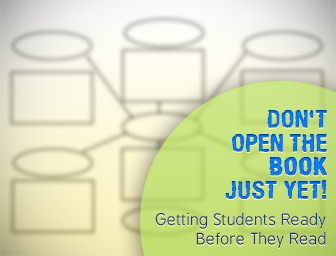When I have a great informational piece I want to share with my students, my temptation is to jump right in.
I have confidence that the fascinating facts and amazing concepts will draw them in just as quickly as they drew me into the subject. The problem with that, though, is that even if they are already interested in the topic of the day, my students can get so much more out of a text if I get them ready to take it in beforehand. In fact, anyone’s reading comprehension will increase when they have some preparation before they go to a text because the preparation helps connect the new facts and ideas to what the reader already knows. This is even truer for speakers of a second language. So even though you may be as excited as me to jump into today’s text with your students, here are some tools you can use to make sure your students get everything they can from your reading selection!

How to Get Students Ready for Reading: Bubble Maps
-
1
Look at the Map
A bubble map is a great way to prepare your students to read about a factual topic. You can put one on the overhead, draw one on the board or give your students a copy to work with at their desks. This map will help your students realize what they already know about any given topic as well as get them thinking about what they would like to learn about it.
-
2
Fill in the Center
The topic you are going to read about goes in the center circle of the map. For example, say you were going to read about families in the U.S. Put that in the middle circle.
-
3
Start Asking Questions
After you introduce the topic for the day, have your students start thinking about what types of information they might like to know about that topic. These topics will go in the six circles around the center one, but for now just choose one. So if you were going to read about families in the U.S., your students might like to know about the members of the family and the relationships between those members. Put this topic in one of the six secondary circles around the center circle.
-
4
Ask Questions
Now your students will take some time to think about that subtopic in depth. Ask your students to think about questions they might have about that area of information. Challenge them to ask interesting questions, questions whose answers will be most exciting or entertaining to most people. For example, rather than asking the question, “Who does the laundry?” your students might ask the question “How do families work together to do housework?” Make sure questions are open ended and start with the journalistic question words (who, what, where, when, why, how) rather than being yes/no questions. You may want to have your students decide which questions are interesting and which aren’t once they get the hang of the activity. Then, write these questions in the box under the appropriate circle.
-
5
Decide on Sub-Topics
Now, ask your students to think about other areas of information they might like to learn about the main topic. You might throw out the question “What other aspects of the topic might you like to learn?” Let your students choose the subtopics that will complete the other five circles in the diagram. They will also make a list of interesting questions for each of these areas.
-
6
Students Question
Now that your students understand how to fill out the bubble map, have them work with a partner or in groups of three to list interesting questions for a second subtopic. After they have had enough time to work, bring the class back together and let students share their questions. You can then list these questions in your model. Let your students work independently to write questions for all of the subtopics, encouraging them to make sure their questions are interesting and that they start with the journalistic questions.
-
7
The Payoff
Now that your students have some interesting questions in mind and have already done quite a bit of thinking about the topic, they are finally ready to read today’s selection! As they read, they will know what type of information they are looking for. Not only that, they will be able to organize that information and their own thoughts as they read. They can even take notes on the bubble diagram and then convert those notes to an outline.
When you use a bubble map to prepare your students to tackle a nonfiction reading selection, you will notice their reading comprehension increases.
They will be better prepared to understand and remember the content that they read, and they will have a clear mental organization of that information. From here, the options are limitless. You may want your students to do further research to answer questions that the selection did not address. You may want them to write a summary of what they read or what they learned. You may have them discuss with a classmate the most interesting thing they learned from the piece. Ultimately, it comes down to this. When you give students some preparation before reading, the positive effects appear in each of your follow up activities.
What do you do to get your students ready to read?
P.S. If you enjoyed this article, please help spread it by clicking one of those sharing buttons below. And if you are interested in more, you should follow our Facebook page where we share more about creative, non-boring ways to teach English.







